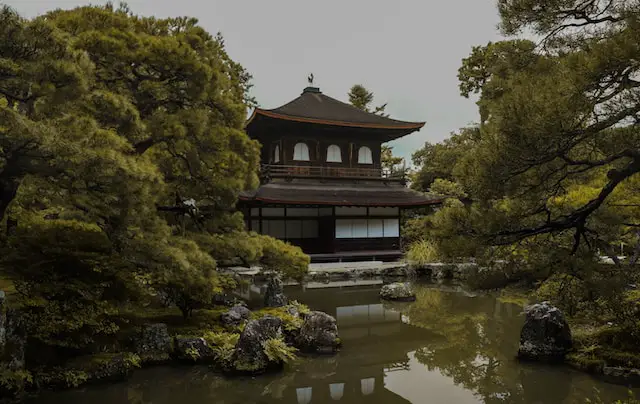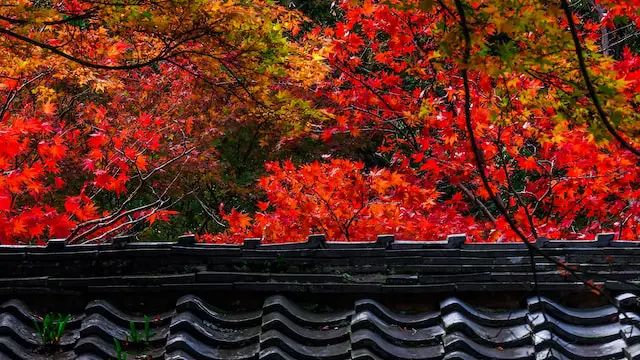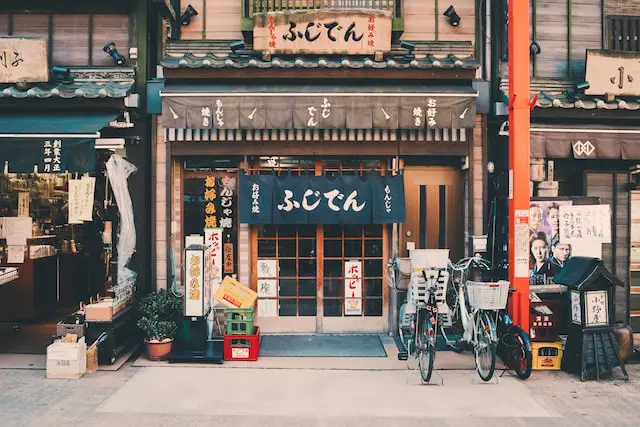Welcome to the enchanting world of Kyoto, the heart of Japan’s history. This city holds a divine relevance in Japan and is often regarded as its Historical City. Every lane and corner whispers tales of ancient times, making Kyoto Travel a delightful journey back in time.
Kyoto is a land of endless beauty and culture, from picturesque temples that touch the soul to majestic castles narrating the stories of shoguns. An exploration of ‘Kyoto’s historic sites’ is a must for any traveler seeking an immersive cultural experience. Each site unfurls a unique chapter of Japanese history, making it an irresistible treat for the culturally curious and history enthusiasts.
Kinkaku-ji History
Emerging as a vision from the beautiful garden surrounding it, Kinkaku-ji, better known as the Golden Pavilion, has proudly stood as a symbol of Kyoto’s rich history since the late 14th century. It was initially designed and established by Shogun Ashikaga Yoshimitsu as a retirement villa. After his death, per his will, the villa was transformed into a Zen Buddhist temple.
This gilded structure has witnessed an array of historical eras and their differing art styles, significantly influencing Japan’s Muromachi period. Although it got burnt down by a novice monk in the mid-20th century, the spectacular recreation done in 1955 stays faithful to its original allure.
Unique Cultural Experiences at Kinkaku-ji
A visit to Kinkaku-ji offers more than just a tour of one of Japan’s renowned UNESCO World Heritage Sites—it’s a step into the nation’s vibrant history and culture. One of the unique experiences here is the Sekka-tei Teahouse, a charming establishment reconstructed during the Edo period. Here, you can enjoy matcha tea and traditional Japanese sweets and view Kinkaku-ji and its fabulous garden from an entirely different perspective.
Additionally, you might wish to explore the smaller Buddhist hall that hosts statues of the Buddha and Yoshimitsu. As you become immersed in the serene ambiance, listen to the soft chirpings of the numerous birds in the garden and the rustling of the leaves. You’re sure to feel a profound connection with Japanese history and spirituality. With every journey to the pavilion, you’ll find that Kinkaku-ji never ceases to amaze.
Ginkaku-ji (Silver Pavilion)
The radiant charm of Kyoto is not limited to its golden marvels. Venture on to the city’s eastern mountains, and you’ll witness the Silver Pavilion, or Ginkaku-ji, nestling amidst nature’s bounty.
Ginkaku-ji Significance
Ginkaku-ji is significant for its aesthetic appeal and its substantial value in Japanese cultural heritage. Built-in 1482 by Shogun Ashikaga Yoshimasa, this temple was meant to emulate Kinkakuji, his grandfather’s golden pavilion. But contrary to the original plan, the pavilion was never covered in silver. Yet, the wooden facades of the pavilion possess an understated elegance that blends harmoniously with the surrounding sand and moss gardens.
Beyond its physical beauty, Ginkaku-ji played a crucial role in the advent of the Higashiyama culture. This era significantly influenced Japanese art, architecture, and gardens, shaping the country’s aesthetics.
Noteworthy Architectural Features of Ginkaku-ji
The elegant two-story Kannon-den is the main temple structure. The villa’s design draws you in with its harmonious fusion of two architectural styles – the Shoin style on the first floor, signifying the aristocratic class of the Heian Period, and the temple style on the upper floor, the Bukke type.
The temple ground also contains a meticulously designed dry sand garden named ‘Sea of Silver Sand.’ The striking feature here is the enigmatic cone structure called the ‘Moon Viewing Platform’, which adds a sense of mystique to the site’s overall aesthetic. Standing there, one can truly appreciate how Ginkaku-ji is a magnificent testament to Japan’s artistic vision and ambition throughout history.
Nijō Castle
If you yearn to experience the ambiance of a bygone era in Japan, Nijō Castle (Nijō-jō) is a must-visit. Built in 1603 by Tokugawa Ieyasu, the first shogun of the Edo period, this castle played a significant role in the shogun era. Enclosed by stone walls and a moat, the court is an iconic reminder of Kyoto’s feudal past, boasting opulent ornamental design and intricate wood carvings that amaze visitors to this very day. Walking through its corridors, where the ‘nightingale floors’ chirp at every step, tantalizing your senses, you can glimpse the shogunate’s life.
Nijō Castle not only holds cultural significance for Japan but also stands as a monument recognized worldwide for its historical importance. It has been a part of the UNESCO World Heritage Sites since 1994 under the collective title – Historic Monuments of Ancient Kyoto. The site and 16 other locations in Kyoto, Uji, and Ōtsu perfectly define Kyoto. These structures represent Japan’s remarkable architectural evolution from the 10th to the 19th century, centered around Shinto and Zen Buddhist religious beliefs. So, while visiting Nijō Castle, explore some other incredible sites embodying a rich tapestry of Japanese culture and history.
Ryoan-ji Temple
Regarded as the epitome of tranquillity and Zen aesthetics, the Ryoan-ji Temple is a site that will transport you to a realm of spiritual awakening. This temple is a quintessential embodiment of Zen Buddhism, serving as a prominent symbol of peacefulness and meditation.
Founded in 1450, Ryoan-ji has weathered centuries while maintaining its symbolic significance and profound impact. The temple’s main attraction is the enigmatic dry landscape rock garden, characterized by its stark yet artistically arranged rocks amidst a sea of raked gravel. This captivating sight provokes deeper introspection and offers a transcendent space for Zen meditation.
The Ryoan-ji Rock Garden, with its Zen aesthetics and takes on the wabi-sabi philosophy, presents an insight into the heart of Japanese aesthetics. With only fifteen rocks and white gravel, the garden’s simplicity is its beauty. Observing this garden, one can appreciate the deeper aspects of Zen Buddhism, providing a profoundly calming and introspective experience.
The Ryoan-ji Temple invites visitors to explore and connect with the Zen spirit, engaging them in a journey of serene reflection and self-examination. With its profound Buddhist principles and the sophisticated, understated beauty of its rock garden, Ryoan-ji serves as an encapsulation of Japanese aesthetics at its finest. Here, you have the opportunity to engage with Japanese cultural heritage while embarking on a spiritual journey like no other.
Tō-ji (Kyō-ō-gokoku-ji)
Steeped in rich history and remarkable beauty, Tō-ji, also known as Kyō-ō-gokoku-ji, catches the fascination of travelers globally. Initiated by Emperor Saga in the early Heian Period (794-1185), its inception purposed to protect the nation and bring prosperity. However, Tō-ji’s historical significance extends far beyond its original intent, recognized by UNESCO as a World Heritage Site. Academics and enthusiasts alike regard this Buddhist temple as a preserve of Japan’s cultural, historical, and architectural splendor.
A major allure here is none other than its famous five-story pagoda, the highest wooden tower in Japan. Representing the cosmic elements (earth, water, fire, wind, and void), it brings to the forefront the intricacies and symbolism of Buddhist cosmology. Ascending skyward, the pagoda impresses not only in its stature but its structural elegance, detailed carvings attributing to its grandeur.
Upon visiting, be sure to take a pause and appreciate the breathtaking panoramic view from the pagoda’s top floor – an unforgettable experience merging timeless history with the vibrant verdant beauty of the present-day temple precincts. A stroll around the temple grounds will also reveal further architectural monuments that resonate with unique aesthetics and philosophical undertones authentic to Japanese tradition.
Experience the repository of Japanese culture that is Tō-ji – an exquisite blend of architectural marvel, nature, and a sweeping narrative of history waiting for exploration.
Fushimi Inari Shrine
Beyond the city’s bustling streets, lying at the base of the Inari Mountain, the Fushimi Inari Shrine tempts visitors with the mystery of its enduring history and vibrant culture. Since its establishment in 711 AD, during the Nara Period, it has been instrumental in Japan’s spiritual and cultural landscape. As the head shrine of Inari, the god of rice, sake, and prosperity, the Fushimi Inari Shrine calls for the heart of every traveler who wishes to witness the amalgamation of faith and history, manifesting in the spiritual tranquility that Japan is known for.
Perhaps the Shrine’s most iconic feature is its Senbon Torii—also known as the Thousand Torii Gates—a vermilion-hued pathway that marks the sacred entrance to the shrine and extends deep into the forest-clad mountain slopes. Walking beneath these vibrant gates feels like stepping into a different realm, made even more surreal by the tranquil hush that surrounds and the mystique inscriptions on each gate, which are, in fact, the name and donation date of the donors. The entire pathway offers a unique hiking experience that not only imbues a sense of spiritual uplifting amongst pious hearts but also provides a blissful escape from the buzzing city life. Along this path, hikers can find many sub-shrines and rest spots, allowing for moments of quiet contemplation amidst splendid natural vistas.
Visiting this iconic site is not just about exploration; it’s about gleaning a unique perspective into one of the cultural corners of Japan that bloom with history and tradition, seemingly cocooned from the lapse of time.
Conclusion
In the cradle of Japan’s rich history and cultural heritage, Kyoto, we have journeyed through time. We have explored several historical sites, each with its unique appeal and tales to tell. From the gleaming Kinkaku-ji (Golden Pavilion), a remnant of Japan’s shōgun era, to the tranquil Ginkaku-ji (Silver Pavilion), projecting the nation’s cultural heritage through its unique architectural features.
Nijō Castle, a symbol of the shōgun era, its robust walls bearing testimony to Japan’s rich history, together with other World Heritage Sites in Kyoto. The peaceful Ryoan-ji Temple, renowned for Zen Buddhism, and its famous rock garden capturing Japanese aesthetics, truly encapsulates the essence of tranquility.
Moving on to Tō-ji (Kyō-ō-gokoku-ji), its history and prominence as a UNESCO World Heritage Site, with the famous Five-story Pagoda marking the Kyoto skyline, serve as a reminder of Japan’s illustrious past. Last but not least, we delved into the mystical Fushimi Inari Shrine, its iconic Thousand Torii Gates, and the unique hiking experience it offers that leave an indelible mark on its visitors.
To every tourist and history enthusiast, Kyoto offers a melting pot of ancient culture, history, and majestic architecture. The city has a unique way of eternally capturing the hearts of those who venture into its historic sites. So, step into an immersive journey that connects you to Japan’s past, and seize the opportunity to appreciate the intricate detail and design of these famous Japanese monuments.




